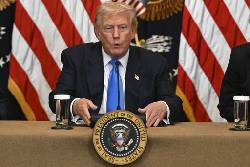WASHINGTON (AP) — The United States will enter a 90-day negotiating period with Mexico over trade as 25% tariff rates stay in place, part of the rush of trade activity Thursday before President Donald Trump plans to impose a broad set of global import taxes starting Friday.
Trump posted on his Truth Social platform that his phone conversation with Mexican leader Claudia Sheinbaum was “very successful in that, more and more, we are getting to know and understand each other.”
The Republican president had threatened tariffs of 30% on goods from Mexico in a July letter, something that Sheinbaum said Mexico gets to stave off for the next three months.
“We avoided the tariff increase announced for tomorrow and we got 90 days to build a long-term agreement through dialogue,” Sheinbaum wrote on X.
The leaders' morning call came at a moment of pressure and uncertainty for the world economy. Nations are scrambling to finalize the outlines of a trade framework with Trump in order to avoid him simply imposing higher tariff rates that could upend economies and governments.
Trump reached a deal with South Korea on Wednesday, and earlier with the European Union, Japan, Indonesia and the Philippines. His commerce secretary, Howard Lutnick, said on Fox News' “Hannity” that there were agreements with Cambodia and Thailand after they had agreed to a ceasefire to their border conflict.
Among those uncertain about their trade status were wealthy Switzerland and Norway.
Norwegian Finance Minister Jens Stoltenberg said it was “completely uncertain” whether a deal would be completed before Trump's deadline.
But even the public announcement of a deal can offer scant reassurance for an American trading partner.
EU officials are waiting to complete a crucial document outlining how the framework to tax imported autos and other goods from the 27-member state bloc would operate. Trump had announced a deal Sunday while he was in Scotland.
“The U.S. has made these commitments. Now it’s up to the U.S. to implement them. The ball is in their court," EU commission spokesman Olof Gill said. The document would not be legally binding.
Trump said as part of the agreement with Mexico that goods imported into the U.S. would continue to face a 25% tariff that he has ostensibly linked to fentanyl trafficking. He said autos would face a 25% tariff, while copper, aluminum and steel would be taxed at 50% during the negotiating period.
He said Mexico would end its “Non Tariff Trade Barriers,” but he didn’t provide specifics.
Some goods continue to be protected from the tariffs by the 2020 U.S.-Mexico-Canada Agreement, or USMCA, which Trump negotiated during his first term.
But Trump appeared to have soured on that deal, which is up for renegotiation next year. One of his first significant moves as president was to tariff goods from both Mexico and Canada earlier this year.
U.S. Census Bureau figures show that the U.S. ran a $171.5 billion trade imbalance with Mexico last year. That means the U.S. bought more goods from Mexico than it sold to the country.
The imbalance with Mexico has grown in the aftermath of the USMCA as it was only $63.3 billion in 2016, the year before Trump started his first term in office.
Besides addressing fentanyl trafficking, Trump has made it a goal to close the trade gap.
___
Associated Press writers Lorne Cook in Brussels and Jamey Keaten in Geneva contributed to this report.
...


 Copyright © 1996 - 2025 CoreComm Internet Services, Inc. All Rights Reserved. | View our
Copyright © 1996 - 2025 CoreComm Internet Services, Inc. All Rights Reserved. | View our